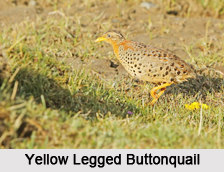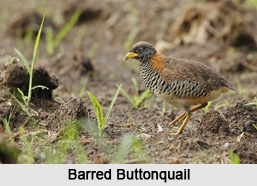 The Indian Subcontinent provides suitable habitats to various species of birds for residing and nesting. Buttonquails are no exception in this regard. Yellow Legged Buttonquail, Barred Buttonquail and Common Buttonquail are the buttonquails which have been recorded in India. They belong to the kingdom, Animalia; phylum, Chordata; class, Aves; order, Charadriiformes; family, Turnicidae; and genus, Turnix. These buttonquails are described below.
The Indian Subcontinent provides suitable habitats to various species of birds for residing and nesting. Buttonquails are no exception in this regard. Yellow Legged Buttonquail, Barred Buttonquail and Common Buttonquail are the buttonquails which have been recorded in India. They belong to the kingdom, Animalia; phylum, Chordata; class, Aves; order, Charadriiformes; family, Turnicidae; and genus, Turnix. These buttonquails are described below.
Yellow Legged Buttonquail
The species of name Yellow Legged Buttonquail is T. Tanki. This buttonquail is endemic to the Indian Subcontinent. The adult male bird has dull yellow colored beak and whitish iris. It has a black crown with a buff margin. The front and side of the head are buff colored. The bird has pale buff colored throat. The individual feathers have black colored tips. Its nape and upper parts of the body and tail are grayish brown in appearance and has reddish and dark brown vermiculations and spotting. The bird has blackish-brown main wing feathers with buff margins. The wing coverts are buff colored with dark spots. The legs and feet are deep yellow in appearance.
The adult female counterpart has brighter yellow beak and legs. The color of the iris is creamy white or yellowish-brown. The bird differs from the male counterpart in terms of being richly colored and in having a broad, reddish-brown collar round the back of the neck. If the bird has dingier plumage, has a less vivid breast color and more fine speckling, it can then be identified as a juvenile.
Barred Buttonquail
The species of name Barred Buttonquail is Turnix Suscitator. This Buttonquail is a resident of India. It has rufous-brown upperparts and rusty and buff lower parts. The chin, throat and breast are closely barred with black. The eyes of the bird are yellowish white. The bird has blue-grey colored bill and legs. The female counterpart is larger and more richly colored. The bird has black colored throat and middle of the breast. The length of Barred Buttonquail ranges from 14 to 18 cm. Its weight ranges from 35 to 50 grams. The female bird may weigh up to 70 grams. This bird depends on insects and seeds for survival. It is important to note that this bird is reluctant to fly.
Common Buttonquail
The species of name Common Buttonquail is Turnix Sylvaticus. This Buttonquail is a resident in India. This bird has streaked sandy brown upperparts and buff underparts, with black flank markings. The face of the bird is plain in color. A whitish wingbar contrasts with the grey wing. Male and female Buttonquails are known to be similar.



















